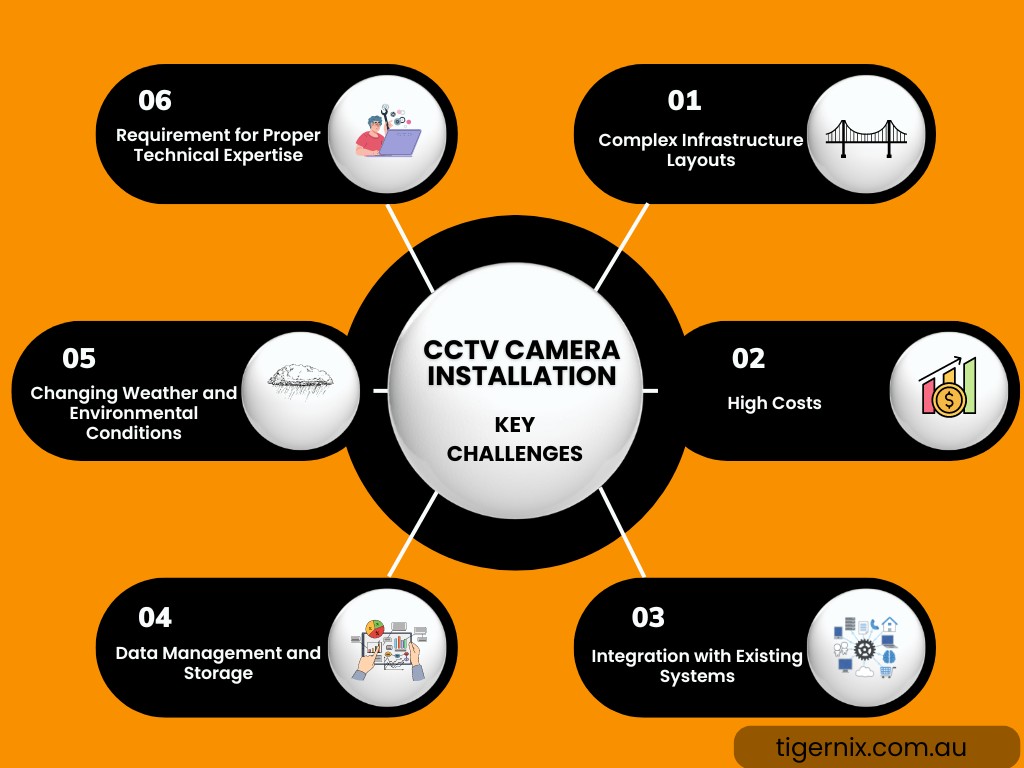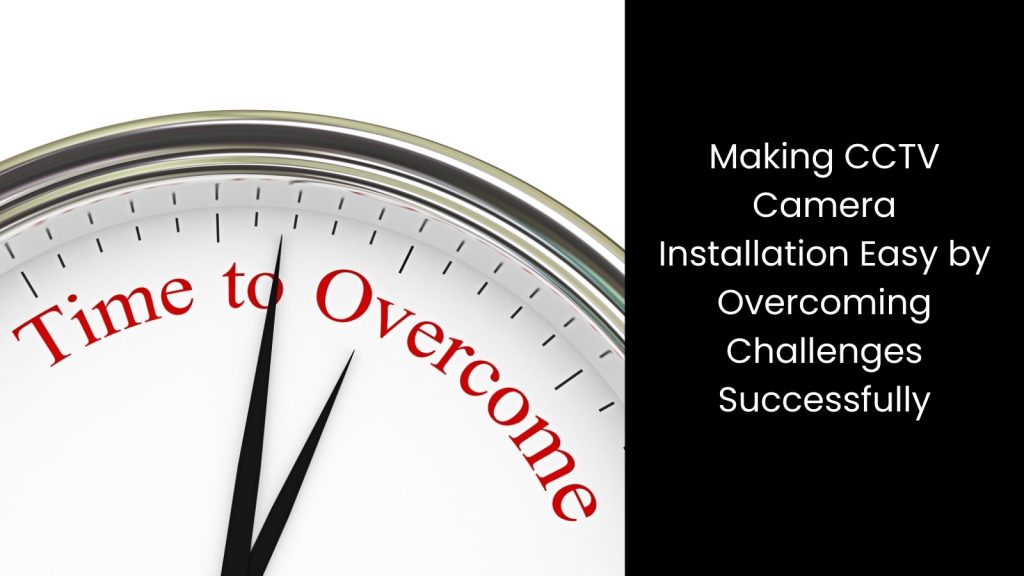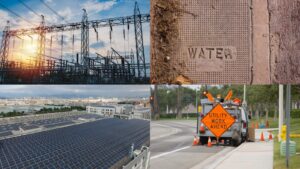How do mega infrastructure projects in Australia ensure the property is 100% safe while the authorities face CCTV camera installation challenges? We know that the rapid advancement of CCTV technology brings sophisticated solutions to modern security needs in Australia. However, we cannot deny the fact that the installation of these systems in large-scale infrastructure projects commonly encounters several hurdles.
In this article, we explore the common challenges encountered during CCTV camera installations in Australia’s vast and varied infrastructure landscape, ranging from roads and bridges to power stations and towers.
In this article, we explore the common challenges encountered during CCTV camera installations in Australia’s vast and varied infrastructure landscape, ranging from roads and bridges to power stations and towers.
Key Challenges of CCTV Camera Installation in Australia

Complex Infrastructure Layouts
We know that Australia is a country that is enriched with a massive number of mega infrastructure projects, such as large transport networks, expansive buildings, or sprawling industrial sites with intricate and extensive layouts. Although it is indeed a fact to be proud of as a nation, this complexity makes it difficult to find the optimal placement and coverage areas for CCTV cameras.
When dealing with such vast and multifaceted environments, planners must account for numerous variables, including the structure’s size, the layout of various components, and the specific security needs of different zones. The vastness and complexity of these projects mean that traditional camera placement strategies might not be effective.
For instance, determining where to place cameras to cover all critical areas without blind spots requires careful planning and advanced technology. The intricate design of these infrastructures normally includes numerous entry and exit points, various levels, and potentially obstructive elements that can interfere with camera views.
Installing CCTV systems in complex settings demands a thorough understanding of the infrastructure’s layout and potential vulnerabilities. It also involves balancing the need for comprehensive coverage with the practicalities of camera installation and maintenance. This is why Australian planners must analyse how best to position each camera to maximise its effectiveness while dealing with the constraints imposed by the infrastructure’s design.
When dealing with such vast and multifaceted environments, planners must account for numerous variables, including the structure’s size, the layout of various components, and the specific security needs of different zones. The vastness and complexity of these projects mean that traditional camera placement strategies might not be effective.
For instance, determining where to place cameras to cover all critical areas without blind spots requires careful planning and advanced technology. The intricate design of these infrastructures normally includes numerous entry and exit points, various levels, and potentially obstructive elements that can interfere with camera views.
Installing CCTV systems in complex settings demands a thorough understanding of the infrastructure’s layout and potential vulnerabilities. It also involves balancing the need for comprehensive coverage with the practicalities of camera installation and maintenance. This is why Australian planners must analyse how best to position each camera to maximise its effectiveness while dealing with the constraints imposed by the infrastructure’s design.
High Costs
It is certainly an unavoidable fact that the high costs associated with CCTV camera installation are problematic.
The installation of CCTV systems in large-scale infrastructure projects can be expensive as it covers various elements like cameras, cabling, storage, and ongoing maintenance. Mega infrastructure projects, such as massive transport hubs, large buildings, or extensive industrial sites, require numerous cameras to ensure thorough surveillance.
Each camera needs a significant investment, and the sheer number needed to cover all critical areas adds up quickly. Also, cabling to connect all cameras to central monitoring systems involves considerable expense on the other hand. The complexity and length of cabling required for such large projects increase both material costs and installation labour. Not to forget that storage solutions for the vast amounts of video data generated by these systems also contribute to high costs.
In the meantime, ongoing maintenance adds another layer of cost. You know that regular upkeep is necessary to ensure that all cameras and equipment function properly over time, and this maintenance work often involves skilled technicians and replacement parts. The overall expense of setting up and maintaining a comprehensive CCTV system in a mega infrastructure project makes it a significant financial burden.
The installation of CCTV systems in large-scale infrastructure projects can be expensive as it covers various elements like cameras, cabling, storage, and ongoing maintenance. Mega infrastructure projects, such as massive transport hubs, large buildings, or extensive industrial sites, require numerous cameras to ensure thorough surveillance.
Each camera needs a significant investment, and the sheer number needed to cover all critical areas adds up quickly. Also, cabling to connect all cameras to central monitoring systems involves considerable expense on the other hand. The complexity and length of cabling required for such large projects increase both material costs and installation labour. Not to forget that storage solutions for the vast amounts of video data generated by these systems also contribute to high costs.
In the meantime, ongoing maintenance adds another layer of cost. You know that regular upkeep is necessary to ensure that all cameras and equipment function properly over time, and this maintenance work often involves skilled technicians and replacement parts. The overall expense of setting up and maintaining a comprehensive CCTV system in a mega infrastructure project makes it a significant financial burden.
Integration with Existing Systems
Let us explain how this becomes a common challenge.
When integrating new CCTV systems with existing security and management systems, it usually requires compatibility and coordination between different technologies. Mega infrastructure projects already have a range of established systems for security, monitoring, and management. This is where the problem comes in.
When introducing a new CCTV system, it must work seamlessly with these pre-existing systems to provide effective surveillance and management. This integration challenge arises because older systems might use outdated technology or different protocols that do not easily connect with modern CCTV systems.
For example, a new CCTV system might use advanced digital communication methods, while older systems rely on analogue signals, creating difficulties in data transfer and system interaction. If they need to ensure that all systems can communicate and operate together without causing conflicts or gaps in coverage, they require detailed planning and technical expertise. However, this would not come inexpensive beyond doubt!
When integrating new CCTV systems with existing security and management systems, it usually requires compatibility and coordination between different technologies. Mega infrastructure projects already have a range of established systems for security, monitoring, and management. This is where the problem comes in.
When introducing a new CCTV system, it must work seamlessly with these pre-existing systems to provide effective surveillance and management. This integration challenge arises because older systems might use outdated technology or different protocols that do not easily connect with modern CCTV systems.
For example, a new CCTV system might use advanced digital communication methods, while older systems rely on analogue signals, creating difficulties in data transfer and system interaction. If they need to ensure that all systems can communicate and operate together without causing conflicts or gaps in coverage, they require detailed planning and technical expertise. However, this would not come inexpensive beyond doubt!
Data Management and Storage
No need to specifically say that handling the large volumes of video data generated by these cameras requires substantial storage capacity and robust data management solutions.
The latter uses numerous CCTV cameras to cover extensive areas. Each camera continuously records video footage, and it creates massive amounts of data. Managing this data involves ensuring that it is stored securely and efficiently, which can be difficult due to its sheer volume. Storing all this video footage indeed requires a large amount of digital storage space, and the storage systems must be both reliable and scalable. If the storage capacity is insufficient, it can lead to data loss or reduced quality of video recordings.
The challenge starts when the system needs to support not just the storage but also the smooth retrieval and analysis of data, which can become complex with large-scale installations. Implementing and maintaining these storage and management systems requires significant financial investment and technical expertise.
The latter uses numerous CCTV cameras to cover extensive areas. Each camera continuously records video footage, and it creates massive amounts of data. Managing this data involves ensuring that it is stored securely and efficiently, which can be difficult due to its sheer volume. Storing all this video footage indeed requires a large amount of digital storage space, and the storage systems must be both reliable and scalable. If the storage capacity is insufficient, it can lead to data loss or reduced quality of video recordings.
The challenge starts when the system needs to support not just the storage but also the smooth retrieval and analysis of data, which can become complex with large-scale installations. Implementing and maintaining these storage and management systems requires significant financial investment and technical expertise.
Changing Weather and Environmental Conditions
Who does not know that Australia’s climate is fluctuating?
Australia’s extreme weather and environmental factors can significantly impact the performance and longevity of outdoor CCTV cameras. It is evident that mega infrastructure projects require the installation of CCTV cameras in exposed outdoor areas where they are subject to harsh conditions.
However, when there are extreme weather situations, such as heavy rain, strong winds, and intense heat, it can directly affect camera functionality. For example, heavy rain can cause water damage, while high temperatures can lead to overheating, which may impair the camera’s performance or even cause it to fail.
Additionally, environmental factors such as high humidity can lead to condensation inside the camera housing, resulting in blurry images or damage to internal components. Meanwhile, dust and debris can also accumulate on the camera lenses or in the housing, obstructing the view and reducing image clarity. Solving these problems needs high levels of technological expertise, which is not as easy as it may seem to be.
Australia’s extreme weather and environmental factors can significantly impact the performance and longevity of outdoor CCTV cameras. It is evident that mega infrastructure projects require the installation of CCTV cameras in exposed outdoor areas where they are subject to harsh conditions.
However, when there are extreme weather situations, such as heavy rain, strong winds, and intense heat, it can directly affect camera functionality. For example, heavy rain can cause water damage, while high temperatures can lead to overheating, which may impair the camera’s performance or even cause it to fail.
Additionally, environmental factors such as high humidity can lead to condensation inside the camera housing, resulting in blurry images or damage to internal components. Meanwhile, dust and debris can also accumulate on the camera lenses or in the housing, obstructing the view and reducing image clarity. Solving these problems needs high levels of technological expertise, which is not as easy as it may seem to be.
Requirement for Proper Technical Expertise
The complex CCTV systems require precise installation and ongoing maintenance, which is a must.
The technology used in these systems includes advanced cameras, sophisticated data management software, and intricate network configurations. This complexity means that installers and maintenance technicians need specialised technical expertise to handle the equipment and troubleshoot any issues effectively.
However, finding professionals with the necessary skills is what is actually challenging. The shortage of qualified technicians with experience in large-scale CCTV systems can delay the installation process and lead to increased costs.
Also, the rapidly evolving nature of CCTV technology means that ongoing training is essential for keeping technicians up-to-date with the latest advancements. Without this specialised expertise, there is a risk of improper installation or system performance, which can undermine the effectiveness of the CCTV system and compromise security.
The technology used in these systems includes advanced cameras, sophisticated data management software, and intricate network configurations. This complexity means that installers and maintenance technicians need specialised technical expertise to handle the equipment and troubleshoot any issues effectively.
However, finding professionals with the necessary skills is what is actually challenging. The shortage of qualified technicians with experience in large-scale CCTV systems can delay the installation process and lead to increased costs.
Also, the rapidly evolving nature of CCTV technology means that ongoing training is essential for keeping technicians up-to-date with the latest advancements. Without this specialised expertise, there is a risk of improper installation or system performance, which can undermine the effectiveness of the CCTV system and compromise security.
Making CCTV Camera Installation Easy by Overcoming Challenges Successfully

It is not necessary to be frustrated knowing the challenges in CCTV installation. The path to successful CCTV camera installation starts with overcoming various hurdles, ranging from technical expertise to environmental impacts. You can accomplish this easily by selecting a proficient solution provider. With the right technologies, expertise, and knowledge, you can navigate these challenges with confidence.







